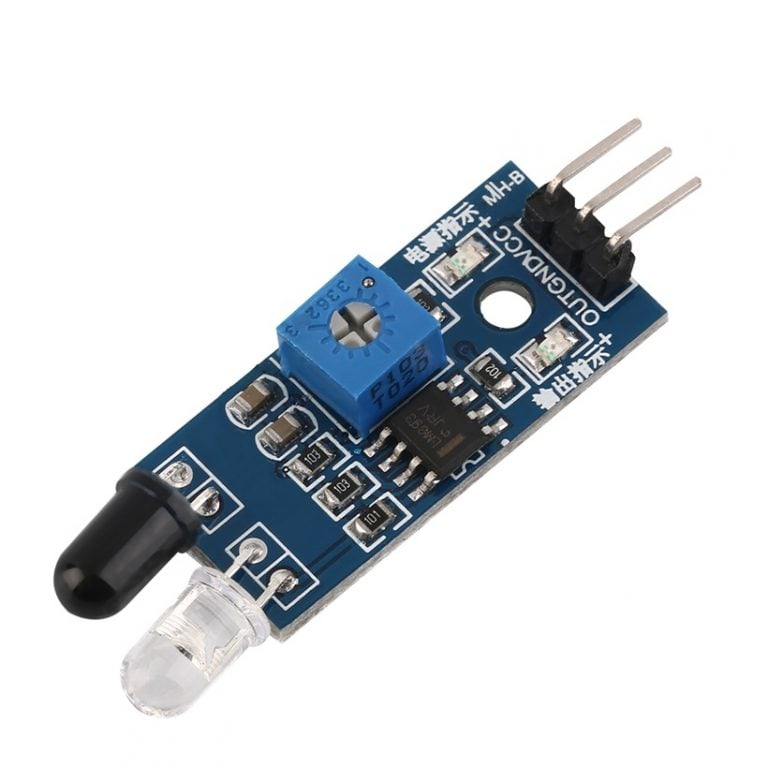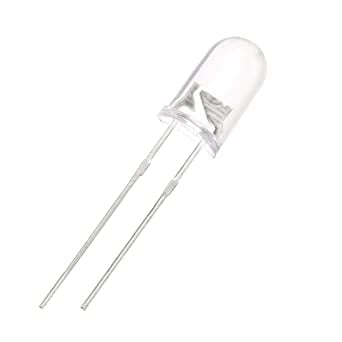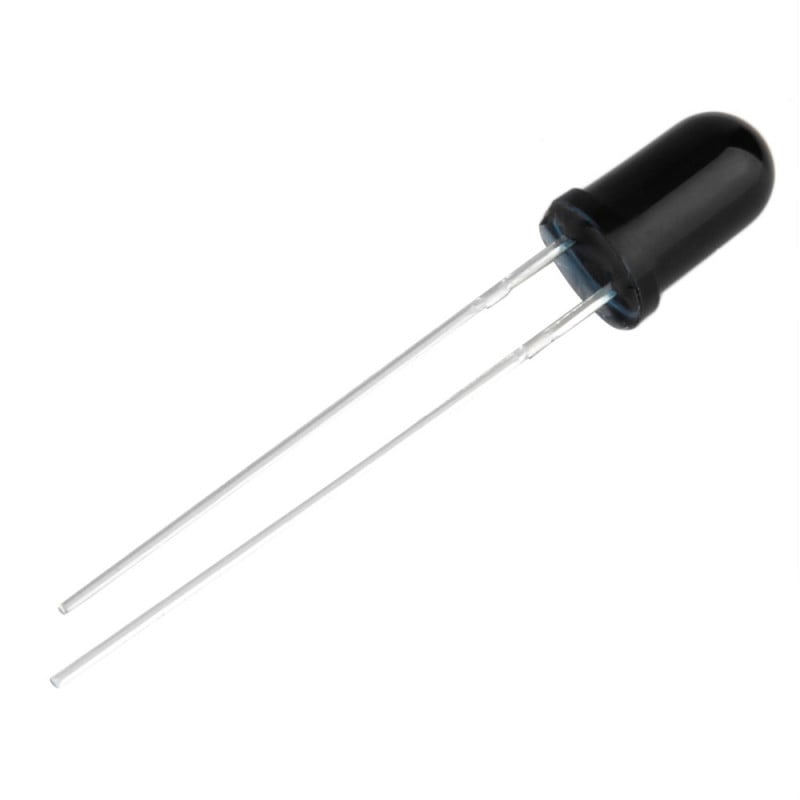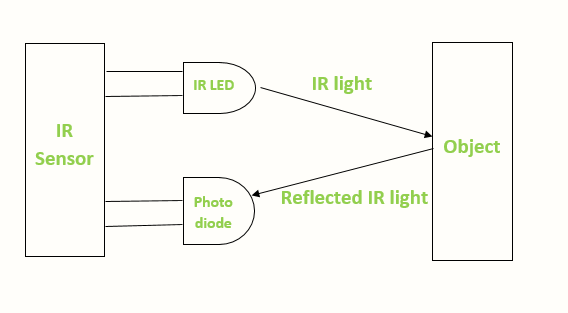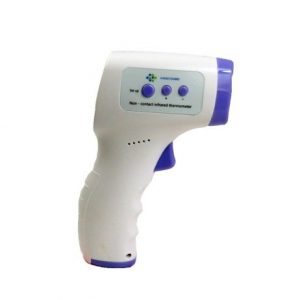In this blog will be talking about the IR sensor working principle and its applications.

Now a days, an Infrared technology has a wide variety of wireless applications mostly in object sensing and remote controls.
In the electromagnetic spectrum, the infrared portion divided into three regions: near infrared region, mid infrared region and far infrared region.
In this blog we are talking about the IR sensor working principle and its applications.
What is an IR Sensor?
IR sensor is an electronic device, that emits the light in order to sense some object of the surroundings. An IR sensor can measure the heat of an object as well as detects the motion. Usually, in the infrared spectrum, all the objects radiate some form of thermal radiation. These types of radiations are invisible to our eyes, but infrared sensor can detect these radiations.
The emitter is simply an IR LED (Light Emitting Diode) and the detector is simply an IR photodiode . Photodiode is sensitive to IR light of the same wavelength which is emitted by the IR LED. When IR light falls on the photodiode, the resistances and the output voltages will change in proportion to the magnitude of the IR light received.
There are five basic elements used in a typical infrared detection system: an infrared source, a transmission medium, optical component, infrared detectors or receivers and signal processing. Infrared lasers and Infrared LED’s of specific wavelength used as infrared sources.
The three main types of media used for infrared transmission are vacuum, atmosphere and optical fibers. Optical components are used to focus the infrared radiation or to limit the spectral response.
Watch this video if you wish to skip the rest of the blog.
Types of IR Sensor
There are two types of IR sensors are available and they are,
- Active Infrared Sensor
- Passive Infrared Sensor
Active Infrared Sensor
Active infrared sensors consist of two elements: infrared source and infrared detector. Infrared sources include the LED or infrared laser diode. Infrared detectors include photodiodes or phototransistors. The energy emitted by the infrared source is reflected by an object and falls on the infrared detector.
Passive Infrared Sensor
Passive infrared sensors are basically Infrared detectors. Passive infrared sensors do not use any infrared source and detector. They are of two types: quantum and thermal. Thermal infrared sensors use infrared energy as the source of heat. Thermocouples, pyroelectric detectors and bolometers are the common types of thermal infrared detectors. Quantum type infrared sensors offer higher detection performance. It is faster than thermal type infrared detectors. The photo sensitivity of quantum type detectors is wavelength dependent.
IR Sensor Working Principle
There are different types of infrared transmitters depending on their wavelengths, output power and response time. An IR sensor consists of an IR LED and an IR Photodiode, together they are called as PhotoCoupler or OptoCoupler.
IR Transmitter or IR LED
Infrared Transmitter is a light emitting diode (LED) which emits infrared radiations called as IR LED’s. Even though an IR LED looks like a normal LED, the radiation emitted by it is invisible to the human eye.
The picture of an Infrared LED is shown below.
IR Receiver or Photodiode
Infrared receivers or infrared sensors detect the radiation from an IR transmitter. IR receivers come in the form of photodiodes and phototransistors. Infrared Photodiodes are different from normal photo diodes as they detect only infrared radiation. Below image shows the picture of an IR receiver or a photodiode,
Different types of IR receivers exist based on the wavelength, voltage, package, etc. When used in an infrared transmitter – receiver combination, the wavelength of the receiver should match with that of the transmitter.
The emitter is an IR LED and the detector is an IR photodiode. The IR photodiode is sensitive to the IR light emitted by an IR LED. The photo-diode’s resistance and output voltage change in proportion to the IR light received. This is the underlying working principle of the IR sensor.
When the IR transmitter emits radiation, it reaches the object and some of the radiation reflects back to the IR receiver. Based on the intensity of the reception by the IR receiver, the output of the sensor defines.
Applications of IR Sensor
IR sensors use in various projects and also in various electronic devices. They all are as follow,
Night Vision Devices
An Infrared technology implemented in night vision equipment if there is not enough visible light available to see unaided. Night vision devices convert ambient photons of light into electrons and then amplify them using a chemical and electrical process before finally converting them back into visible light.
Radiation Thermometers
IR sensos uses in radiation thermometers to measure the temperature depend upon the temperature and the material of the object and these thermometers have some of the following features
- Measurement without direct contact with the object
- Faster response
- Easy pattern measurements
Infrared Tracking
An Infrared tracking or Infrared homing, is a missile guidance system which operates using the infrared electromagnetic radiation emitted from a target to track it.
IR Imaging Devices
IR image device is one of the major applications of IR waves, primarily by virtue of its property that is not visible. It uses for thermal imagers, night vision devices etc.
Other Key Application Areas
Other key application areas that use infrared sensors include:
- Climatology
- Meteorology
- Photobiomodulation
- Flame Monitors
- Gas detectors
- Water analysis
- Moisture Analyzers
- Anesthesiology testing
- Petroleum exploration
- Rail safety
- Gas Analyzers
Hope this article helps you to understand about the working principle of IR sensor and its application. To know more about IR sensor, you can refer the blog Interfacing of IR Sensor with Arduino.


